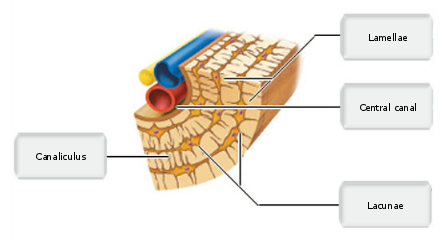The Osteon Or Haversian System Quiz Questions. With the exception of the kneecap wrist and ankle bones all the bones of the limbs are long bones.

Osteon Development Structure Osteoblast Osteocyte Osteoclast Stock Osteoblast Osteoclast The Incredibles
The osteon or haversian system h ə ˈ v ɜːr.

. Only compact bones have osteons as a basic structural unit. Blood vessels within this tissue deliver nutrients to osteocytes and remove waste. Sixty-five percent of the mass of bone is a compound called hydroxyapatite.
Their length is often hard to define but estimates vary from several millimeters to around 1 centimeter. Spongy bones dont have osteons. Bone has hard matrix and not gel like.
An osteon is a few millimeters in length and has a diameter of approximately 02 mm 31 32. After all the blood supply of all osteons originates precisely from the circulatory network of the periosteum and then passes into the vessels of the bone marrow. The osteocytes of spongy bone are located within a lattice of bony plates known as trabeculae.
Osteons are units of bone. All the following statements are true except for the osteon absorbs stress in all directions equally. Which of the.
2 matrix of cartilage is made up View the full answer. Osteon the chief structural unit of compact cortical bone consisting of concentric bone layers called lamellae which surround a long hollow passageway the Haversian canal named for Clopton Havers a 17th-century English physician. Which of the following is a function of the skeletal system.
An osteon contains osteocytes lamellae and a central canal and is found in compact bone only. The hypodermis is composed of connective tissue and is not part of the skin. Start studying Parts of Osteon.
The Haversian canal contains small blood vessels responsible for the blood supply to osteocytes individual bone cells. Which of the following is not true. The term osteoid refers to the organic part of the matrix of compact bones.
All bones stop growing by the end of adolescense. The Dermis is composed of connective tissue and is part of the skin. Which of the following are components of compact bone but not of an osteon.
Which of the following is NOT a bone of the axial skeleton. It provides protection and strength to bones. Spongy bone tissue does not contain osteons that constitute compact bone tissue.
Learn vocabulary terms and more with flashcards games and other study tools. Canaliculi allow for diffusion of substances between the cells and the marrow. The Epidermis is composed of stratified squamous epithelium and is part of the skin.
1 gel like matrix is not part of osteon. ʒ ən named for Clopton Havers is the fundamental functional unit of much compact boneOsteons are roughly cylindrical structures that are typically between 025 mm and 035 mm in diameter. Instead it consists of trabeculae which are lamellae that are arranged as rods or plates.
Spongy bone does not possess the typical osteon units of compact bone. Inside the cement line are concentric layers of bone lamellae made of. Red bone marrow is found between the trabuculae.
Compact bone tissue consists of units called osteons or Haversian systems. Osteon - textend is not a separate structural unit it repeatedly anastomoses between other units as well as with the periosteum and the vessels of the bone marrow. They are present in many bones of most.
Compact bone or cortical bone forms the hard external layer of all bones and surrounds the medullary cavity or bone marrow. They are composed of a shaft and two ends. In which of the following bone structures do osteocytes live.
They are called long bones as their length is more than their width. A perforating canals and circumferential lamellae B central canal and concentric lamellae C osteocytes lacunae and canaliculi D all of the above are parts of an osteon. Starting from the outside of the osteon and moving inward the osteon is rimmed by the cement line a band of less stiff material with an important role in resisting fracture 33.

Osteon Labeled Anatomy And Physiology Physiology Anatomy

History Travel Arts Science People Places Cancellous Bone Anatomy Bones Skeletal System


0 Comments